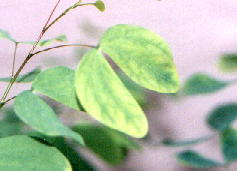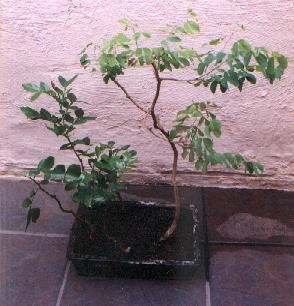I originally labelled this tree as "Currently Unknown" because it was a rescued tree that was thought to be a
Mopane tree (A tree indigenous to Southern Africa). Research confirmed this.
Species Information
This is one of the principle trees of the hot, low lying areas of south tropical Africa, reaching its southernmost limit just south of the Olifants River in the Kruger National Park in Mpumalanga, South Africa. The tree can be found in Mpumalanga, Botswana, Zimbabwe and Mozambique. It often grows in alluvial soils, but tolerates alkaline and poorly drained soils better than many other species do. The Mopane is one of the most distinctive vegetation groups, often forming pure Mopane forests. These have given rise to the now accepted term "Mopane Woodland" which has an atmosphere entirely of its own.
- Height: A medium to large tree 4-18m in height, usually about 10m.
- Bark: The bark is dark grey to blackish, and is characteristically deeply, vertically fissured and flaking in narrow strips.
- Leaves:The leaves are alternate and compound, drooping with two leaflets arising close together to resemble a butterfly. The old remains of a third terminal leaflet forms a very small appendage between this pair of leaflets. The leaves are ovate, roughly 1,5-5 X 4,5-10 cm, dotted with translucent glands and a tapering apex. The base is markedly assymetrical and slightly lobed on one side, with a margin that surrounds the leaf entirely. The leaves usually fold down at sunset, but open out into the distinctive butterfly shape at sunrise.
- Flowers: The flowers are inconspicuous and small. They are greenish in colour with no petals, 4 greenish sepals and 20-25 stamens hanging out of the flowers. They appear in short axillary racemes/sprays, flowering usually between October and March, but can be erratic with no flowers being produced at all for several years.
- Fruit: Flattened, oval pod that is leathery and not woody. Fruit usually appears between March and June. The seeds are distinctive, flat, conspicuously convoluted, sticky and abundantly dotted with resin glands.
The leaves of the Mopane provide important fodder and many animals, including cattle, browse on them eagerly and even eat the dry pods off the ground. Although the pods smell strongly of turpentine, neither their milk nor meat is tainted as a result.
Caterpillars of a large brownish-grey moth (Gonimbrasia Belina) - commonly called Mopane Worms - feed on the leaves. They are distinctly vivid in colour and despite their somewhat alarming appearance, they are eagerly sought after by the locals as part of their diet. Mopane Worms are high in protein and are thus an important ingredient of locals' diets. They are roasted and in times of plenty, dried out to be stored for many months.
In Autumn, the leaves of the Mopane turn yellow and then brown and are shed irregularly in the following months, leaving most of the trees bare by the end of winter. The seeds germinate easily, provided they are planted while still in the pod. They are slow growing and susceptible to damping-off.
Mopane wood is dark reddish-brown to almost black in colour. It is very durable, hard and heavy, and although it is quite difficult to work with, many beautiful pieces of furniture have been made from it. It has also been used extensively for mine props and as railway sleepers. It makes very good firewood, giving off a sweet smell and an intense heat.
My Tree
Here is the story on how I rescued this tree:



